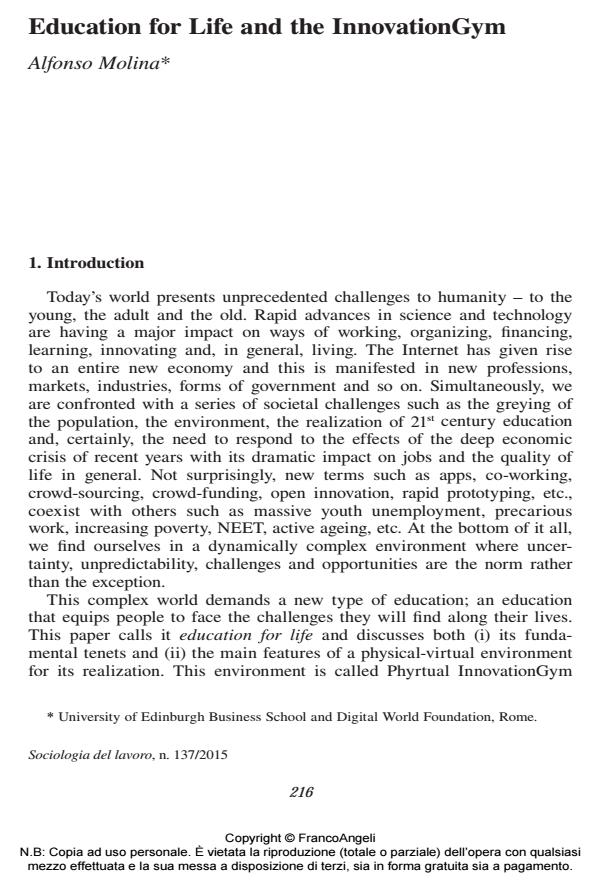Education for Life and the InnovationGym
Titolo Rivista SOCIOLOGIA DEL LAVORO
Autori/Curatori Alfonso Molina
Anno di pubblicazione 2015 Fascicolo 2015/137
Lingua Inglese Numero pagine 15 P. 216-230 Dimensione file 176 KB
DOI 10.3280/SL2015-137013
Il DOI è il codice a barre della proprietà intellettuale: per saperne di più
clicca qui
Qui sotto puoi vedere in anteprima la prima pagina di questo articolo.
Se questo articolo ti interessa, lo puoi acquistare (e scaricare in formato pdf) seguendo le facili indicazioni per acquistare il download credit. Acquista Download Credits per scaricare questo Articolo in formato PDF

FrancoAngeli è membro della Publishers International Linking Association, Inc (PILA)associazione indipendente e non profit per facilitare (attraverso i servizi tecnologici implementati da CrossRef.org) l’accesso degli studiosi ai contenuti digitali nelle pubblicazioni professionali e scientifiche
The 21st century is presenting unprecedented challenges to human development. Rapid advances in science and technology are having a widespread impact in all walks of life from jobs, industry, finance to education, health and leisure. Add to this, the tendency towards systemic crises affecting the financial and economic systems and we find ourselves in a dynamically complex environment where uncertainty, unpredictability, challenges and opportunities are the norm rather than the exception. This complex world demands a new type of education; an education that equips people to face the challenges they will find along their lives. This paper calls it education for life and discusses both (i) its fundamental tenets and (ii) the main features of a physical-virtual environment for its realization. This environment is called Phyrtual InnovationGym and is part of the strategic work of the Fondazione Mondo Digitale, Rome, within the Italian school system. The InnovationGym represents both: (1) an environment to realize the concept of education for life, and (2) a mechanism to stimulate a gradual systemic innovation across the Italian school system.
Il XXI secolo presenta sfide senza precedenti per lo sviluppo umano. I rapidi progressi nella scienza e nella tecnologia esercitano un impatto esteso a tutti gli ambiti dell’esistenza, dal settore lavorativo, industriale e finanziario fino all’educazione, la sanità e il tempo libero. In aggiunta, la tendenza a periodi di crisi sistemiche che colpiscono i sistemi finanziari ed economici: siamo costretti a vivere in un ambiente dinamico e complesso in cui l’incertezza, l’imprevedibilità, le sfide e le opportunità non sono un’eccezione ma una realtà comune. Questo mondo complesso richiede un nuovo sistema educativo, che renda le persone in grado di affrontare le sfide a cui dovranno far fronte nel corso della loro vita. Il presente saggio lo definisce educazione per la vita e tratta sia (i) i principi fondamentali sia (ii) le principali caratteristiche dell’ambiente fisico-virtuale necessario alla sua realizzazione. Tale ambiente viene chiamato "Phyrtual InnovationGym" (Palestra dell’innovazione) e forma parte del lavoro strategico della Fondazione Mondo Digitale di Roma all’interno del sistema scolastico italiano. Esso rappresenta sia: (1) un ambiente in cui realizzare il concetto di educazione per la vita, sia (2) un meccanismo in grado di stimolare la graduale innovazione sistemica nel sistema scolastico italiano.
Parole chiave:Sviluppo umano, educazione continua, spazio di apprendimento fisico e virtuale, Phyrtual InnovationGym
Alfonso Molina, Education for Life and the InnovationGym in "SOCIOLOGIA DEL LAVORO " 137/2015, pp 216-230, DOI: 10.3280/SL2015-137013